light LINCOLN AVIATOR 2023 Owner's Manual
[x] Cancel search | Manufacturer: LINCOLN, Model Year: 2023, Model line: AVIATOR, Model: LINCOLN AVIATOR 2023Pages: 681, PDF Size: 9.33 MB
Page 121 of 681
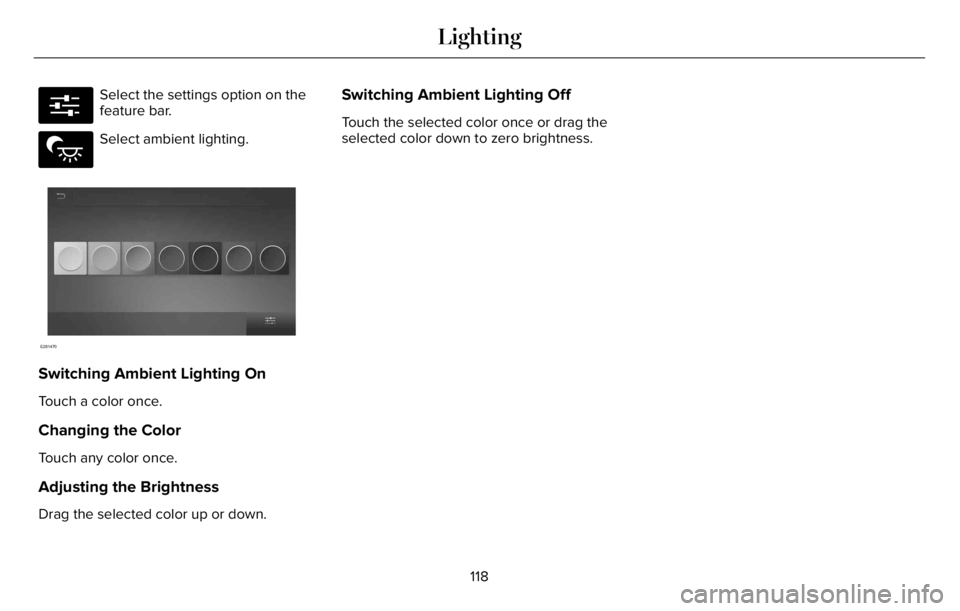
E280315
Select the settings option on the
feature bar.
E279027
Select ambient lighting.
E281470
Switching Ambient Lighting On
Touch a color once.
Changing the Color
Touch any color once.
Adjusting the Brightness
Drag the selected color up or down.
Switching Ambient Lighting Off
Touch the selected color once or drag the
selected color down to zero brightness.
118
Lighting
Page 122 of 681
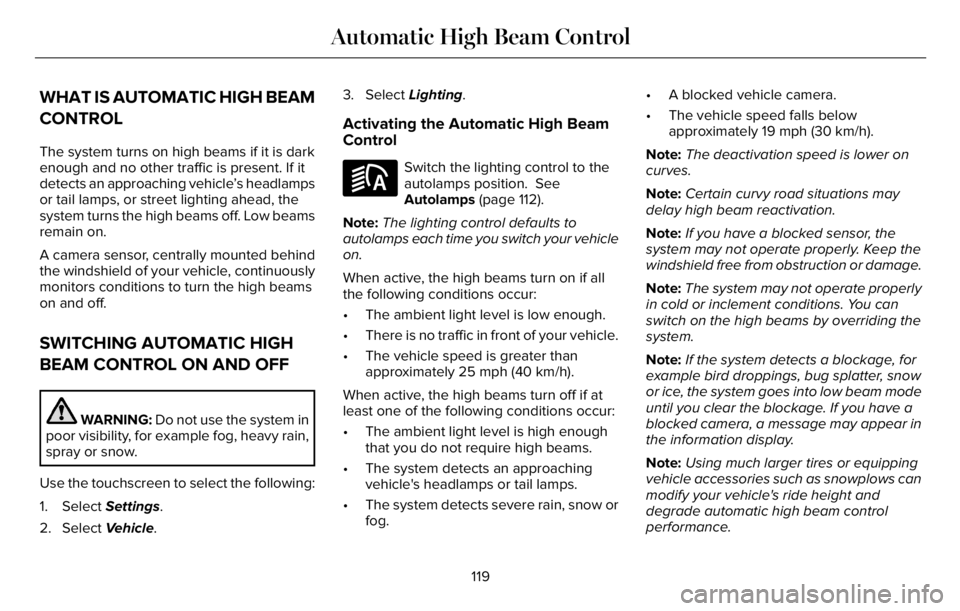
WHAT IS AUTOMATIC HIGH BEAM
CONTROL
The system turns on high beams if it is dark
enough and no other traffic is present. If it
detects an approaching vehicle’s headlamps
or tail lamps, or street lighting ahead, the
system turns the high beams off. Low beams
remain on.
A camera sensor, centrally mounted behind
the windshield of your vehicle, continuously
monitors conditions to turn the high beams
on and off.
SWITCHING AUTOMATIC HIGH
BEAM CONTROL ON AND OFF
WARNING: Do not use the system in
poor visibility, for example fog, heavy rain,
spray or snow.
Use the touchscreen to select the following:
1. Select Settings.
2. Select Vehicle.3. Select Lighting.
Activating the Automatic High Beam
Control
E281240
Switch the lighting control to the
autolamps position. See
Autolamps (page 112).
Note:The lighting control defaults to
autolamps each time you switch your vehicle
on.
When active, the high beams turn on if all
the following conditions occur:
• The ambient light level is low enough.
• There is no traffic in front of your vehicle.
• The vehicle speed is greater than
approximately 25 mph (40 km/h).
When active, the high beams turn off if at
least one of the following conditions occur:
• The ambient light level is high enough
that you do not require high beams.
• The system detects an approaching
vehicle's headlamps or tail lamps.
• The system detects severe rain, snow or
fog.• A blocked vehicle camera.
• The vehicle speed falls below
approximately 19 mph (30 km/h).
Note:The deactivation speed is lower on
curves.
Note:Certain curvy road situations may
delay high beam reactivation.
Note:If you have a blocked sensor, the
system may not operate properly. Keep the
windshield free from obstruction or damage.
Note:The system may not operate properly
in cold or inclement conditions. You can
switch on the high beams by overriding the
system.
Note:If the system detects a blockage, for
example bird droppings, bug splatter, snow
or ice, the system goes into low beam mode
until you clear the blockage. If you have a
blocked camera, a message may appear in
the information display.
Note:Using much larger tires or equipping
vehicle accessories such as snowplows can
modify your vehicle's ride height and
degrade automatic high beam control
performance.
119
Automatic High Beam Control
Page 124 of 681
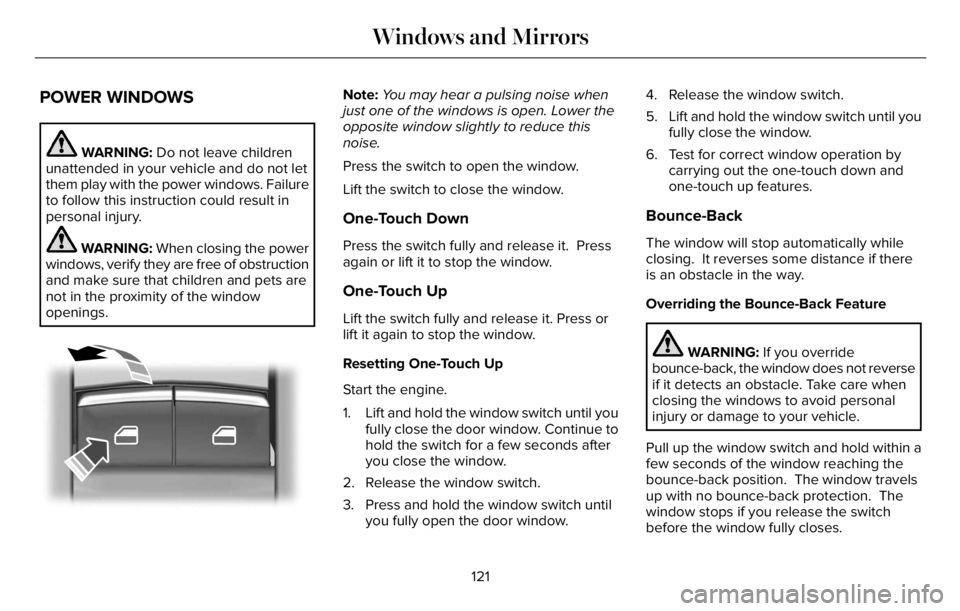
POWER WINDOWS
WARNING: Do not leave children
unattended in your vehicle and do not let
them play with the power windows. Failure
to follow this instruction could result in
personal injury.
WARNING: When closing the power
windows, verify they are free of obstruction
and make sure that children and pets are
not in the proximity of the window
openings.
E295317
Note:You may hear a pulsing noise when
just one of the windows is open. Lower the
opposite window slightly to reduce this
noise.
Press the switch to open the window.
Lift the switch to close the window.
One-Touch Down
Press the switch fully and release it. Press
again or lift it to stop the window.
One-Touch Up
Lift the switch fully and release it. Press or
lift it again to stop the window.
Resetting One-Touch Up
Start the engine.
1. Lift and hold the window switch until you
fully close the door window. Continue to
hold the switch for a few seconds after
you close the window.
2. Release the window switch.
3. Press and hold the window switch until
you fully open the door window.4. Release the window switch.
5. Lift and hold the window switch until you
fully close the window.
6. Test for correct window operation by
carrying out the one-touch down and
one-touch up features.
Bounce-Back
The window will stop automatically while
closing. It reverses some distance if there
is an obstacle in the way.
Overriding the Bounce-Back Feature
WARNING: If you override
bounce-back, the window does not reverse
if it detects an obstacle. Take care when
closing the windows to avoid personal
injury or damage to your vehicle.
Pull up the window switch and hold within a
few seconds of the window reaching the
bounce-back position. The window travels
up with no bounce-back protection. The
window stops if you release the switch
before the window fully closes.
121
Windows and Mirrors
Page 126 of 681
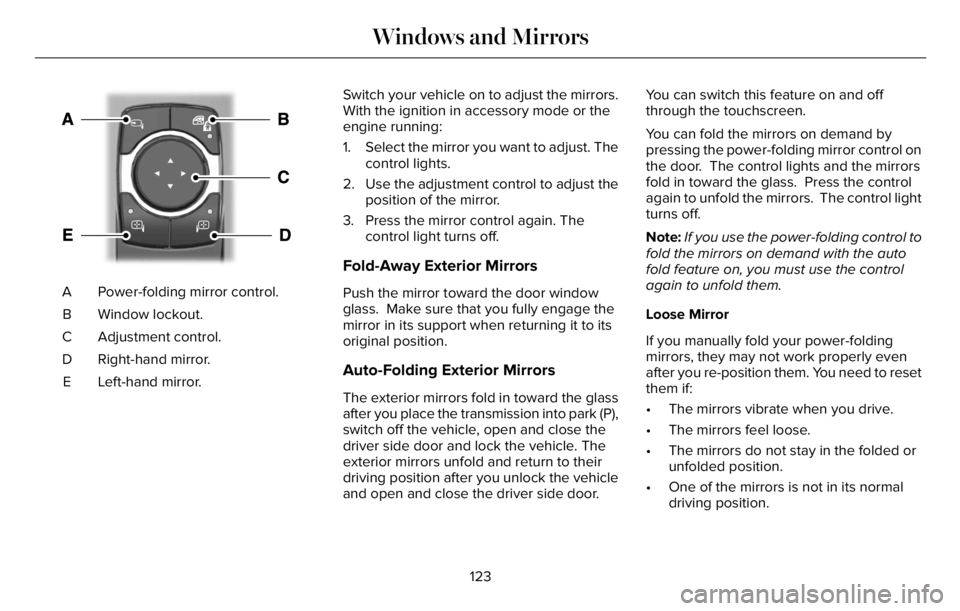
E295322
Power-folding mirror control. A
Window lockout. B
Adjustment control. C
Right-hand mirror. D
Left-hand mirror. ESwitch your vehicle on to adjust the mirrors.
With the ignition in accessory mode or the
engine running:
1. Select the mirror you want to adjust. The
control lights.
2. Use the adjustment control to adjust the
position of the mirror.
3. Press the mirror control again. The
control light turns off.
Fold-Away Exterior Mirrors
Push the mirror toward the door window
glass. Make sure that you fully engage the
mirror in its support when returning it to its
original position.
Auto-Folding Exterior Mirrors
The exterior mirrors fold in toward the glass
after you place the transmission into park (P),
switch off the vehicle, open and close the
driver side door and lock the vehicle. The
exterior mirrors unfold and return to their
driving position after you unlock the vehicle
and open and close the driver side door.You can switch this feature on and off
through the touchscreen.
You can fold the mirrors on demand by
pressing the power-folding mirror control on
the door. The control lights and the mirrors
fold in toward the glass. Press the control
again to unfold the mirrors. The control light
turns off.
Note:If you use the power-folding control to
fold the mirrors on demand with the auto
fold feature on, you must use the control
again to unfold them.
Loose Mirror
If you manually fold your power-folding
mirrors, they may not work properly even
after you re-position them. You need to reset
them if:
• The mirrors vibrate when you drive.
• The mirrors feel loose.
• The mirrors do not stay in the folded or
unfolded position.
• One of the mirrors is not in its normal
driving position.
123
Windows and Mirrors
Page 127 of 681
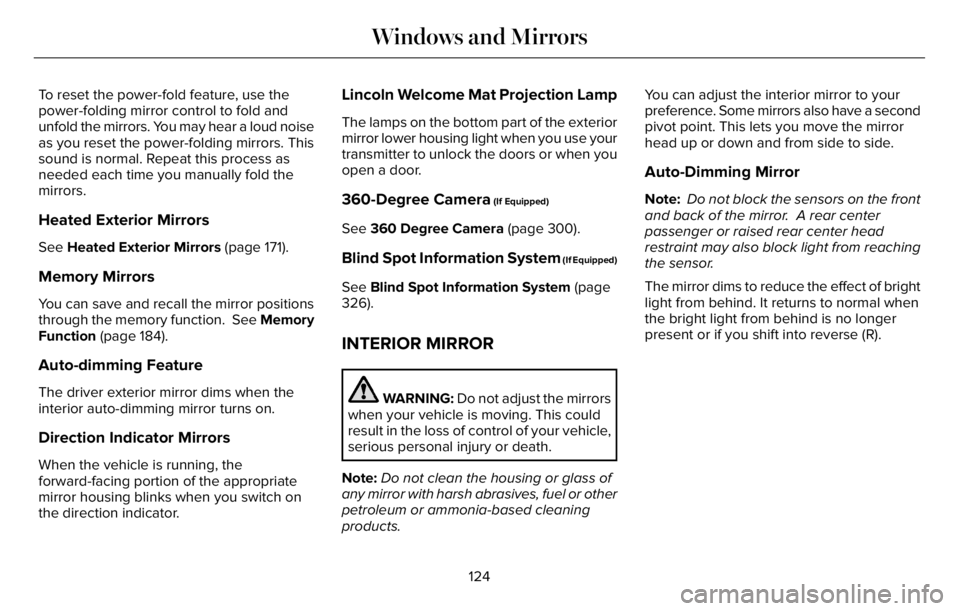
To reset the power-fold feature, use the
power-folding mirror control to fold and
unfold the mirrors. You may hear a loud noise
as you reset the power-folding mirrors. This
sound is normal. Repeat this process as
needed each time you manually fold the
mirrors.
Heated Exterior Mirrors
See Heated Exterior Mirrors (page 171).
Memory Mirrors
You can save and recall the mirror positions
through the memory function. See Memory
Function (page 184).
Auto-dimming Feature
The driver exterior mirror dims when the
interior auto-dimming mirror turns on.
Direction Indicator Mirrors
When the vehicle is running, the
forward-facing portion of the appropriate
mirror housing blinks when you switch on
the direction indicator.
Lincoln Welcome Mat Projection Lamp
The lamps on the bottom part of the exterior
mirror lower housing light when you use your
transmitter to unlock the doors or when you
open a door.
360-Degree Camera (If Equipped)
See 360 Degree Camera (page 300).
Blind Spot Information System (If Equipped)
See Blind Spot Information System (page
326).
INTERIOR MIRROR
WARNING: Do not adjust the mirrors
when your vehicle is moving. This could
result in the loss of control of your vehicle,
serious personal injury or death.
Note:Do not clean the housing or glass of
any mirror with harsh abrasives, fuel or other
petroleum or ammonia-based cleaning
products.You can adjust the interior mirror to your
preference. Some mirrors also have a second
pivot point. This lets you move the mirror
head up or down and from side to side.
Auto-Dimming Mirror
Note: Do not block the sensors on the front
and back of the mirror. A rear center
passenger or raised rear center head
restraint may also block light from reaching
the sensor.
The mirror dims to reduce the effect of bright
light from behind. It returns to normal when
the bright light from behind is no longer
present or if you shift into reverse (R).
124
Windows and Mirrors
Page 132 of 681
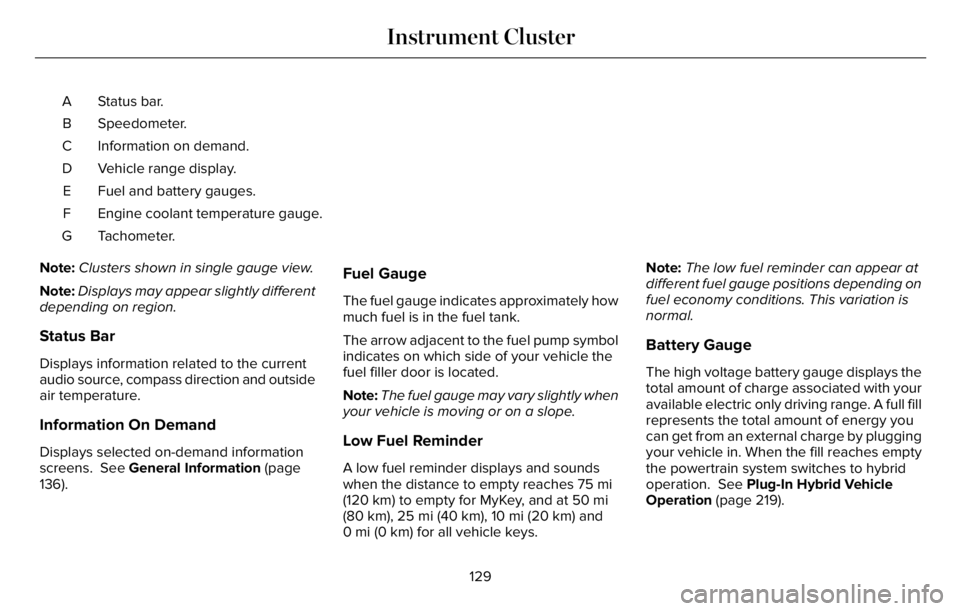
Status bar. A
Speedometer. B
Information on demand. C
Vehicle range display. D
Fuel and battery gauges. E
Engine coolant temperature gauge. F
Tachometer. G
Note:Clusters shown in single gauge view.
Note:Displays may appear slightly different
depending on region.
Status Bar
Displays information related to the current
audio source, compass direction and outside
air temperature.
Information On Demand
Displays selected on-demand information
screens. See General Information (page
136).
Fuel Gauge
The fuel gauge indicates approximately how
much fuel is in the fuel tank.
The arrow adjacent to the fuel pump symbol
indicates on which side of your vehicle the
fuel filler door is located.
Note:The fuel gauge may vary slightly when
your vehicle is moving or on a slope.
Low Fuel Reminder
A low fuel reminder displays and sounds
when the distance to empty reaches 75 mi
(120 km) to empty for MyKey, and at 50 mi
(80 km), 25 mi (40 km), 10 mi (20 km) and
0 mi (0 km) for all vehicle keys.Note:The low fuel reminder can appear at
different fuel gauge positions depending on
fuel economy conditions. This variation is
normal.
Battery Gauge
The high voltage battery gauge displays the
total amount of charge associated with your
available electric only driving range. A full fill
represents the total amount of energy you
can get from an external charge by plugging
your vehicle in. When the fill reaches empty
the powertrain system switches to hybrid
operation. See Plug-In Hybrid Vehicle
Operation (page 219).
129
Instrument Cluster
Page 134 of 681
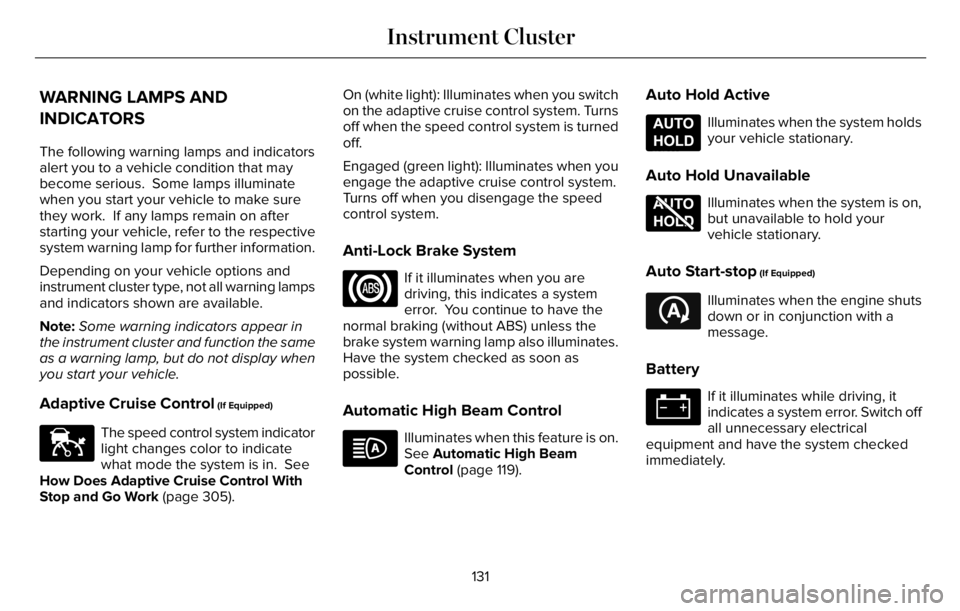
WARNING LAMPS AND
INDICATORS
The following warning lamps and indicators
alert you to a vehicle condition that may
become serious. Some lamps illuminate
when you start your vehicle to make sure
they work. If any lamps remain on after
starting your vehicle, refer to the respective
system warning lamp for further information.
Depending on your vehicle options and
instrument cluster type, not all warning lamps
and indicators shown are available.
Note:Some warning indicators appear in
the instrument cluster and function the same
as a warning lamp, but do not display when
you start your vehicle.
Adaptive Cruise Control (If Equipped)
E144524
The speed control system indicator
light changes color to indicate
what mode the system is in. See
How Does Adaptive Cruise Control With
Stop and Go Work (page 305).On (white light): Illuminates when you switch
on the adaptive cruise control system. Turns
off when the speed control system is turned
off.
Engaged (green light): Illuminates when you
engage the adaptive cruise control system.
Turns off when you disengage the speed
control system.
Anti-Lock Brake System
If it illuminates when you are
driving, this indicates a system
error. You continue to have the
normal braking (without ABS) unless the
brake system warning lamp also illuminates.
Have the system checked as soon as
possible.
Automatic High Beam Control
Illuminates when this feature is on.
See Automatic High Beam
Control (page 119).
Auto Hold Active
E197933
Illuminates when the system holds
your vehicle stationary.
Auto Hold Unavailable
E197934
Illuminates when the system is on,
but unavailable to hold your
vehicle stationary.
Auto Start-stop (If Equipped)
E121377
Illuminates when the engine shuts
down or in conjunction with a
message.
Battery
If it illuminates while driving, it
indicates a system error. Switch off
all unnecessary electrical
equipment and have the system checked
immediately.
131
Instrument Cluster
Page 140 of 681
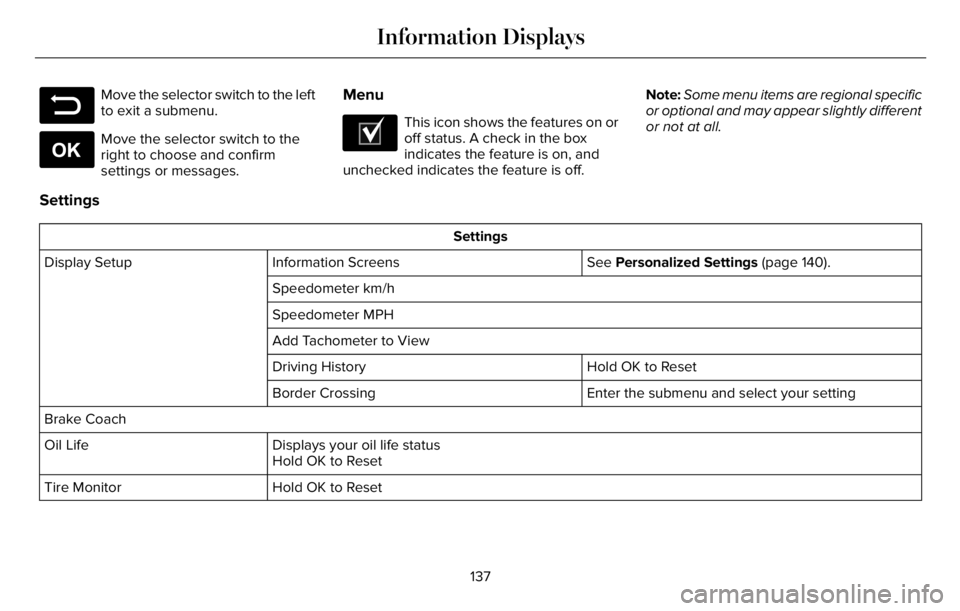
E281480
Move the selector switch to the left
to exit a submenu.
E265041
Move the selector switch to the
right to choose and confirm
settings or messages.
Menu
E204495
This icon shows the features on or
off status. A check in the box
indicates the feature is on, and
unchecked indicates the feature is off.Note:Some menu items are regional specific
or optional and may appear slightly different
or not at all.
Settings
Settings
See Personalized Settings (page 140). Information Screens Display Setup
Speedometer km/h
Speedometer MPH
Add Tachometer to View
Hold OK to Reset Driving History
Enter the submenu and select your setting Border Crossing
Brake Coach
Displays your oil life status Oil Life
Hold OK to Reset
Hold OK to Reset Tire Monitor
137
Information Displays
Page 143 of 681
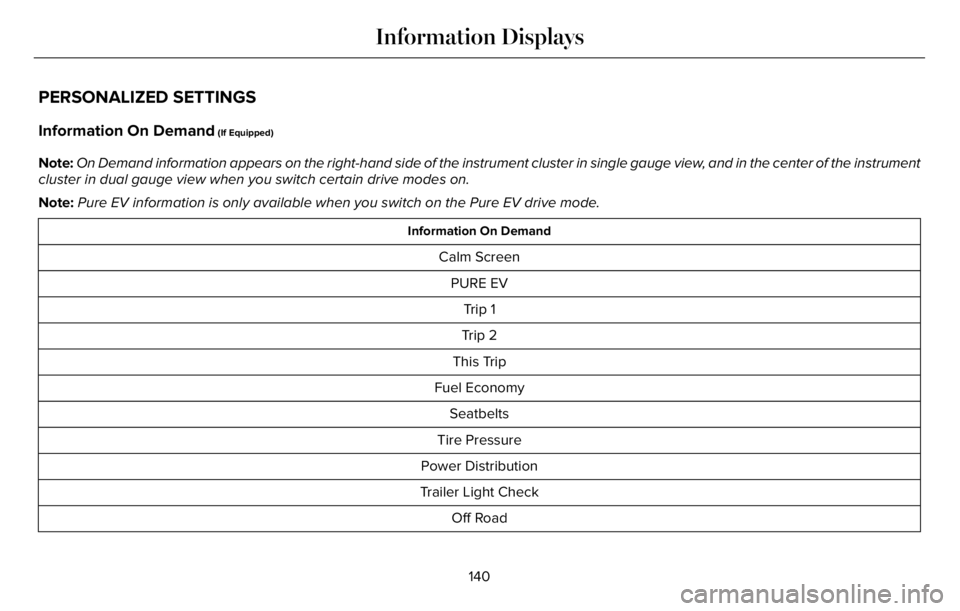
PERSONALIZED SETTINGS
Information On Demand (If Equipped)
Note:On Demand information appears on the right-hand side of the instrument cluster in single gauge view, and in the center of the instrument
cluster in dual gauge view when you switch certain drive modes on.
Note:Pure EV information is only available when you switch on the Pure EV drive mode.
Information On Demand
Calm Screen
PURE EV
Trip 1
Trip 2
This Trip
Fuel Economy
Seatbelts
Tire Pressure
Power Distribution
Trailer Light Check
Off Road
140
Information Displays
Page 154 of 681
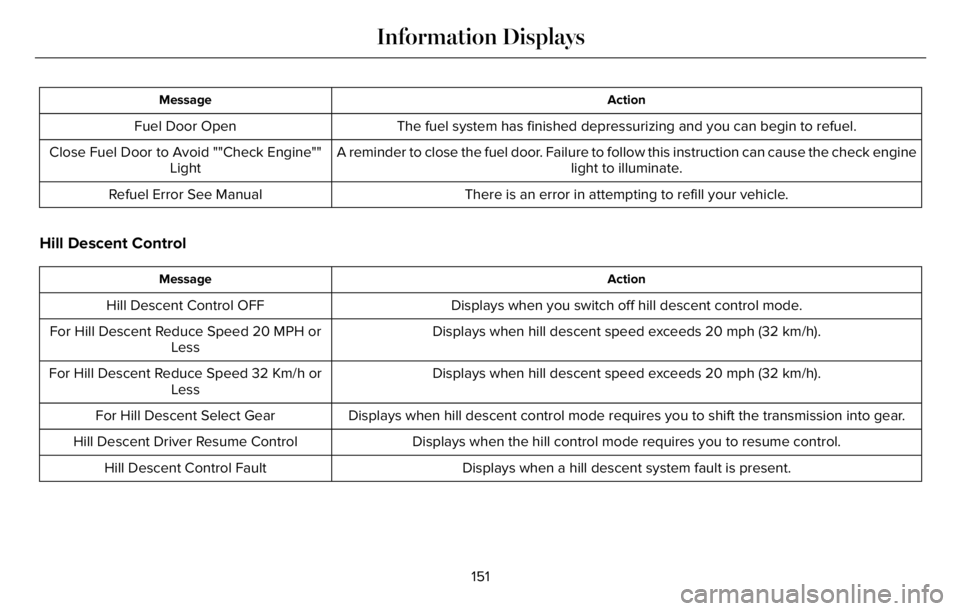
Action Message
The fuel system has finished depressurizing and you can begin to refuel. Fuel Door Open
A reminder to close the fuel door. Failure to follow this instruction can cause the check engine
light to illuminate. Close Fuel Door to Avoid ""Check Engine""
Light
There is an error in attempting to refill your vehicle. Refuel Error See Manual
Hill Descent Control
Action Message
Displays when you switch off hill descent control mode. Hill Descent Control OFF
Displays when hill descent speed exceeds 20 mph (32 km/h). For Hill Descent Reduce Speed 20 MPH or
Less
Displays when hill descent speed exceeds 20 mph (32 km/h). For Hill Descent Reduce Speed 32 Km/h or
Less
Displays when hill descent control mode requires you to shift the transmission into gear. For Hill Descent Select Gear
Displays when the hill control mode requires you to resume control. Hill Descent Driver Resume Control
Displays when a hill descent system fault is present. Hill Descent Control Fault
151
Information Displays